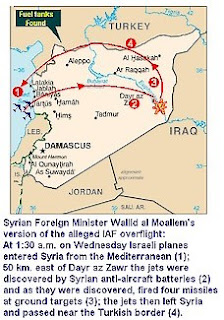A little over a year after its war with Hizballah, Israel has apparently struck at weapons intended for the group, and Syrian military facilities used to support the delivery process.
Both CNN and the Jerusalem Post are reporting that last week’s raid went far beyond an “accidental incursion” in Syrian airspace, as the event was originally described. Damascus claimed that its air defenses fired on Israeli fighters which entered northern Syria last Thursday. Spokesman for the Israeli Defense Forces have refused comment on the original report and on the details that have emerged in recent days.
“…Sources told CNN the military operation, which happened Wednesday into Thursday, may have also involved Israeli ground forces who directed the airstrike which “left a big hole in the desert” in Syria.
The strike may have targeted Hezbollah weapons coming into Syria or transiting through the country from Iran — a pattern over the past three or four years which has occurred without any retaliation or action taken against it — the sources said.
The Israeli government is very happy with the success of the operation, the sources said.
The Post has a copy of the graphic which shows the Syrian version of events, depicting a flight path that took Israeli jets across northern Lebanon and Syria before striking targets near the Iraqi border.
If that version of events is accurate, then Damascus should find it very disturbing, for a variety of reasons. First, take a look at this graphic, depicting operational Syrian Air Force bases (courtesy of the Dutch aviation magazine Scramble, a superb on-line resource).
If you believe the Syrian foreign minister, then the Israelis flew through the heart of his nation’s air defenses–apparently undetected–to strike at targets near the country’s eastern border. And it wouldn’t be the first time that the IAF has accomplished such a feat; in 2003, Israeli jets struck a Palestinian terrorist complex near Damascus, taking advantage of confusion within the Syrian air defense system to bomb the target and escape, with no reaction from fighters or ground-based air defenses. The success of this particular raid suggests that despite a reported shake-up of the Syria’s air defense organization, the system remains incapable of defeating an Israeli attack.
And, making matters worse, the IDF raid apparently included a ground attack, featuring commandos that were (presumably) ferried in by helicopter. While IAF CH-53 Sea Stallions have the range (540 NM) to reach distant targets, getting the chopper(s) and the commandos in and out of enemy territory was indeed an impressive feat. Apparently, the Syrians fared no better against the heliborne element of the mission than they did against the IAF jets. However, given the location of the target area–and initial Syrian comments about Israeli aircraft “coming out of Turkey,” it’s quite possible that the helicopters (and commando elements) staged from a “foreign” base.
As for their mission, some analysts might suggest that the Israeli ground teams were dispatched to “designate” the target for precision weapons dropped by Israeli fighters. But with all IAF F-16 and F-15I squadrons now JDAM capable, the need for laser designation has decreased. More than likely, the IDF commandos were on the ground for a secondary demolition mission, or (more likely) to kill or capture high-value assets.
In its coverage of the event, Time magazine suggests that the Israeli raid might be connected to the acquisition of Russian-made Pantsyr-1 air defense systems by Syria and Iran. Damascus took initial deliveries of the system in August, and Iranian crews are likely training on the Pantsyr as well. But the destruction of an air defense training site wouldn’t account for that “big hole” in the desert. The attack was apparently concentrated in an area that’s not far from known Syrian surface-to-surface missile facilities. Given the scope of the damage inflicted–and the apparent size of the Israeli strike force–we’re guessing that the attack was aimed at more than air defense equipment.
In any case, it looks like Hizballah’s order-of-battle will be missing a few items, at least temporarily. The raid was also a wake-up call for Damascus and Tehran, reminding them that the IDF can reach remote targets with air and ground forces. And finally, the strike illustrates that “Syrian Air Defense” is still an oxymoron, no matter how much hardware they buy from the Russians, or anyone else.
***
ADDENDUM: Last week’s Israeli raid came six months after a former Iranian Revolutionary Guards Corps (IRGC) Commander, General Ali Reza Asghari, defected to the west. Media reporting suggests that General Asghari–who helped create Hizballah and was Iran’s senior military official in Lebanon for years–is now in the United States, along with his family. But what are the odds that information from a former IRGC commander, a man with itimate knowledge of the Iran/Syria/Hizballah relationship, might have provided some information that prompted the IDF raid in eastern Syria?




